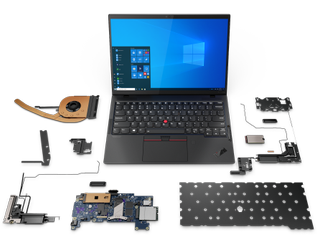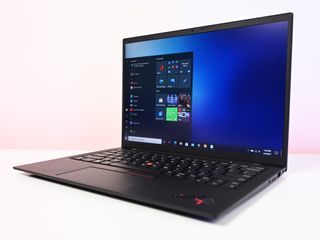

Smaller Carbon Copy
The first-generation X1 Nano is the lightest ThinkPad Lenovo has ever made, but that doesn't mean it skimps on features and build quality. This is everything you love about the X1 line, shrunk down to fit in a 13-inch chassis that weighs just 2.12 pounds (962g).
For
- Compact, lightweight, and durable
- 16:10 AR display with 2K resolution
- 11th Gen Intel Core vPro CPUs
- IR camera and Human Presence Detection
- Thunderbolt 4 and optional 5G
Against
- Might want a larger display
- RAM is soldered
- Expensive

14-Inch Business Partner
Lenovo has made the move to 16:10 display, 11th Gen Intel Core CPUs, and optional 5G in its ninth-generation X1 Carbon laptops. If you prefer a ThinkPad with 14-inch display that's just a bit larger and heavier than the X1 Nano, the X1 Carbon should be for you.
For
- 16:10 displays with FHD, UHD resolutions
- 11th Gen Intel Core vPro CPUs
- IR camera and Human Presence Detection
- Better port selection and optional 5G
- More screen space at 14 inches
Against
- RAM is soldered
- Expensive
These two ThinkPad X1 laptops share a lot of traits, and you should be able to get most of the features you want in either PC. Let's take a look first at some raw specs before moving into design, display, performance, and price.
ThinkPad X1 Nano vs. X1 Carbon tech specs
| Header Cell - Column 0 | ThinkPad X1 Nano (Gen 1) | ThinkPad X1 Carbon (Gen 9) |
|---|---|---|
| OS | Windows 10 HomeWindows 10 ProLinux | WIndows 10 HomeWindows 10 ProLinux |
| Processor | 11th Gen IntelCore i5-1130G7Core i5-1140G7 vProCore i7-1160G7Core i7-1180G7 vPro | 11th Gen IntelCore i5-1135G7Core i5-1145G7 vProCore i7-1165G7Core i7-1185G7 vPro |
| RAM | 8GB, 16GBLPDDR4x-4266 | 8GB, 16GB, 32GBLPDDR4x-4266 |
| Graphics | IntegratedIntel Iris Xe | IntegratedIntel Iris Xe |
| Storage | Up to 1TBM.2 PCIe 3.0 NVMe SSD | Up to 2TBM.2 PCIe 4.0 SSD |
| Display | 13 inches2160x1350 (2K)16:10 aspect ratioLow powerTouch, IPS, AR, 450 nitsNon-touch, IPS, AG, 450 nits | 14 inches1920x1200 (FHD+)16:10 aspect ratioLow powerAnti-glareNon-touch, IPS, 400 nits, Low Blue LightTouch, IPS, 400 nits, Low Blue LightTouch, IPS, 500 nits, Privacy Guard3840x2400 (UHD+)16:10 aspect ratioNon-touch, IPS, 500 nits, Low Blue Light |
| Ports | Two Thunderbolt 43.5mm audioNano-SIM (optional) | Two Thunderbolt 4Two USB-A 3.2HDMI 2.03.5mm audioNano-SIM (optional) |
| Audio | Dual 2W woofersDual 1W tweetersDolby Atmos | Dual 2WDual 0.8WDolby Atmos |
| Connectivity | Wi-Fi 6 AX201Bluetooth 5.14G, 5G (optional) | Wi-Fi 6 AX201Bluetooth 5.14G, 5G (optional) |
| Camera | Front-facing 720pIR camera (optional) | Front-facing 720pIR camera (optional) |
| Security | dTPM 2.0Fingerprint readerWebcam shutterHuman Presence Detection (optional) | dTPM 2.0Fingerprint readerWebcam shutterHuman Presence Detection (optional) |
| Battery | 48Wh65W AC adapter | 57Wh45W, 65W AC adapter |
| Dimensions | 11.53 x 8.18 x 0.55-0.66 inches(292.8mm x 207.7mm x 13.87-16.7mm) | 12.4 x 8.72 x 0.59 inches(315mm x 221.6mm x 14.9mm) |
| Weight | From 1.99 pounds (907g) | 2.49 pounds (1.13kg) |
| Color | Black | Black |
ThinkPad X1 Nano vs. X1 Carbon Design and features

When Lenovo announced the ThinkPad X1 Nano in late 2020, many people compared it to the X1 Carbon. These two laptops come from the same family, though the X1 Nano is sized at 13 inches compared to X1 Carbon's 14 inches. The Nano is about a half-pound lighter than the X1 Carbon at just 1.99 pounds (907g), and also shaves about an inch off the width. The Nano is actually a bit thicker than the X1 Carbon at the chunky side of its wedge shape. Both laptops employ a durable carbon fiber top and magnesium alloy bottom, and both have the standard ThinkPad black finish.
The X1 Carbon's extra space is taken up by far better port selection. It has two Thunderbolt 4, two USB-A 3.2, HDMI 2.0, a 3.5mm audio jack, and a Nano-SIM card slot on the WWAN models. The X1 Nano has just two Thunderbolt 4, a 3.5mm audio jack, and the same optional Nano-SIM slot. If you'd rather not use dongles or one of the best laptop docking stations, the X1 Carbon is much more generous.
Both laptops come with Intel AX201 Wi-Fi 6 and Bluetooth 5.1. You can also outfit each with 4G and 5G connectivity if needed, allowing you to keep in touch even when you're outside of Wi-Fi range. Lenovo lists the X1 Nano as having eSIM capabilities, which the X1 Carbon seems to lack, according to reference documents.

The keyboards here are standard ThinkPad fare. That means you can't do much better in modern laptops in terms of key travel, spacing, and overall comfort. Keys are backlit, and each has unified communication controls to make conferencing and video chatting just a bit easier. The Precision touchpad is accompanied by the ThinkPad TrackPoint system, a boon for anyone who prefers the physical mouse buttons and red pointing nub.
Both laptops offer some robust security features, including a fingerprint reader, webcam shutter, and dTPM 2.0 chip on all models. An IR camera for Windows Hello is optional on both PCs, but it'd make a great pairing with Human Presence Detection capabilities (also optional). If you want your PC to automatically unlock when you approach and lock when you leave, this is the way to go. Note that only the X1 Carbon provides a Kensington lock slot.
ThinkPad X1 Nano vs. X1 Carbon Display
A big change to the X1 Carbon is the move to a 16:10 display aspect ratio, something the X1 Nano debuted with. This provides some extra pixels along the top and bottom for more productivity space; a great change all around.
Get the Windows Central Newsletter
All the latest news, reviews, and guides for Windows and Xbox diehards.
The X1 Nano's 13-inch IPS display has a 2160x1350 resolution (what Lenovo calls 2K), available in touch and non-touch. The Touch version hits 450 nits brightness, 100% sRGB color reproduction, and has an anti-reflective finish to cut down on glare. The non-touch version hits the same 450 nits and 100% sRGB color, but it has an anti-glare finish. Both displays are considered "low power" to help with battery life.
The Nano's displays are quite attractive, but the X1 Carbon is the way to go if you'd rather have FHD+ or UHD+. There are three display options set at 1920x1200, one non-touch and three touch. All have an anti-glare finish, 100% sRGB color, and are considered low power. One also includes a privacy guard to keep unwanted eyes away, as well as 500 nits brightness. The other FHD+ models hit 400 nits and have low blue light output.
The X1 Carbon's UHD+ (3840x2400) display is non-touch, has a glossy finish, hits 100% DCI-P3 color, and has low blue light output. For those who need better coverage of the DCI-P3 color gamut for design or photo work, this is really your only option between the two laptops. And if you prefer an anti-reflective display finish, the X1 Nano is the way to go.
ThinkPad X1 Nano vs. X1 Carbon performance and price

Both laptops are using Intel's 11th Gen Core mobile CPUs with vPro options available. However, the chips aren't quite the same. The X1 Carbon uses the Core i5-1145G7 and Core i7-1165G7 (and their vPro variants), whereas the X1 Nano uses the Core i5-1130G7 and Core i7-1160G7 (and their vPro variants). The CPUs in the Nano are clocked lower but also draw less power. Compared side-by-side, you should get better raw performance from the X1 Carbon.
No matter what, integrated Intel Iris Xe graphics are included for excellent performance up to 80% better than previous-gen integrated GPUs. These are both laptops certified for Intel's Evo platform, so performance is snappy even on battery power. We've yet to test battery life in either laptop, but Lenovo claims about 14 hours in the Nano and 17 hours in the X1 Carbon with MobileMark 2018.
All RAM is soldered in these PCs, so you'll want to get as much as needed from the factory. The Nano tops out at 16GB while the Carbon tops out at 32GB. You can also get more storage (up to 2TB) in the X1 Carbon, as well as PCIe 4.0 compatibility. The X1 Nano's largest M.2 PCIe 3.0 NVMe SSD is 1TB.

The ninth-generation X1 Carbon was only recently released, and Lenovo doesn't yet have a wide selection of models available. Pricing is also quite high at the moment, with introductory models sitting around the $2,819 mark. Expect that to drop significantly, especially with Lenovo's frequent in-house coupons and sales.
The X1 Nano has been on the market for a while longer, with models starting at the $1,150 mark. If you'd like one of these laptops today, the X1 Nano should be much easier on the wallet.
Be sure to take a look at our best Windows laptop roundup if neither of these laptops are really what you're looking for.

Cale Hunt brings to Windows Central more than eight years of experience writing about laptops, PCs, accessories, games, and beyond. If it runs Windows or in some way complements the hardware, there’s a good chance he knows about it, has written about it, or is already busy testing it.